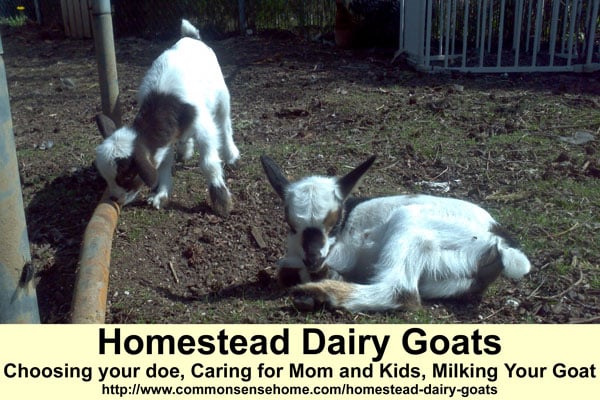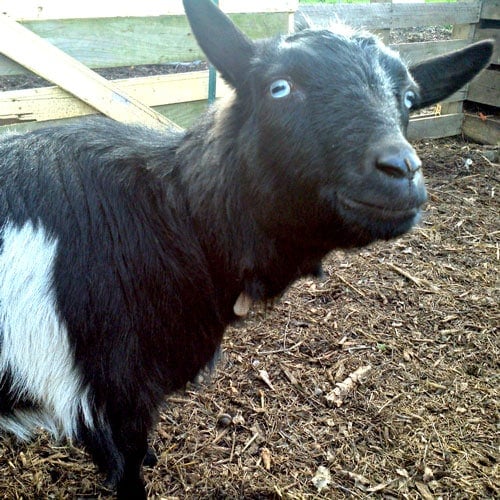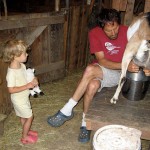Keeping Homestead Dairy Goats – An Introduction
This post may contain affiliate links. Read my full disclosure here.
One of the most popular reasons for adding goats to the homestead is as dairy animals. Once you decide that keeping dairy goats is right for you, and you can accommodate them on your homestead, there are a few more considerations before getting your first pail of milk.

Keeping Homestead Dairy Goats: What Age To Get
One way to begin keeping dairy goats is to purchase doelings. You get to be there as the animal grows, and train them to a lead and the milking stand. You can become very bonded to the animal and have them be very used to you. This is a good way of obtaining high quality stock and also avoiding possible behavior problems. The biggest downside is there’s quite a long wait from the time you bring the animal home to the time you get your first taste of their milk.
Another option is to purchase a fully grown bred doe. You don’t have to worry about waiting so long before starting to milk or about breeding the doe. You can care for the goat throughout her pregnancy and get to be there for the hopping bundles of cuteness that are goat kids. Depending on how far along she is when you purchase her, and whether or not the pregnancy was confirmed with blood tests, there is the risk of her not taking to the breeding.
If you don’t want to bother with kidding when you first get started with goats a good option is to purchase a doe already in milk. This is a doe who has already kidded. You will be able to know how much milk she is producing, and, depending on her age, how long she will continue to produce well. Of course the risks of purchasing an older animal are that they probably won’t be the top producers of the herd you’re buying from, and they may not have been trained well, or have bad habits that are difficult to change.

Breeding Your Dairy Goat
Goats will experience a drop in their milk supply during the winter, and possibly even completely dry up. Some goats can be milked through, but even if you start out with a bred doe or a goat in milk at some point you will need to breed your goats. Most dairy goats go into heat only once a year, in the fall. The exception is Nigerian Dwarf goats. Nigerian Dwarf does go into heat about every 28 days, and the bucks can be used year round.
Before deciding to keep dairy goats it’s important to have a plan for breeding. If there are no studs available, or in your breed, you will need to have separate housing for your own buck. Goats are not happy alone, so a wether (castrated male) is also needed as a companion for your buck.
If there are plenty of available studs in your area for your breed then you won’t need your own buck, but you will most likely need to provide proof that your does are disease free before dropping them off to be bred or having a buck come come for a visit.
Basic Pregnancy Care
Before breeding you should de-worm your goats and if you live in a selenium deficient area supplement them with selenium. Make sure you write down the date they were bred so you know when to expect kids. A goat’s gestation lasts for about 150 days. Not much extra needs to be done while a goat is in early pregnancy, but make sure to keep her hooves trimmed because that will become more difficult once her belly gets bigger.
About two months before her due date doe’s nutritional needs increase, so use quality grass hay and add in grain twice a day. If she is already in milk, dry her off. One month before kidding, does should be given selenium (if you live in a selenium deficient area) and a CD&T vaccine to prevent tetanus for the babies. One week before kidding de-worm your doe again and make sure you have any birthing supplies you need on hand.
Most goats kid smoothly and without needing assistance, but before you midwife your first goat birth it’s a good idea to research some potential issues and steps you can take to help if something does go wrong.
Kids and Weaning
Once your doe has kidded and she starts producing milk she will need extra nutrition. Keep up her grain rations and give her the best hay possible. You can bottle feed the kids or dam raise them. Both options have a lot of positives and a few drawbacks. Bottle raising kids can be time intensive and they can be overly friendly. Dam raised kids can be a bit more aloof, but they will still be friendly if they are handled a lot. If dam raising you can wait until the kids wean completely before milking for your own use, or you can pen the kids up at night after they turn two weeks old and milk the doe out in the morning. The kids get to spend the day with their mother before returning to their pen for the night again.
Would you like to save this?

Basic Milking Procedures and Milk Handling
Few things taste as delicious as fresh goats milk, but make sure you handle it correctly to prevent a goaty flavor. Before milking wash the does udder to remove any debris. Baby wipes work really well, and there are also specially formulated udder washes available.
Milking a goat is best figured out through doing it. If you’ve never milked an animal before it may take a while to get the hang of it. Using your thumb and index finger close off the top of the teat so that the milk can’t flow up into the udder, then use the rest of your fingers to gently but firmly push the milk out of the teat. Remember not to pull on the teat, that will only hurt the doe without producing any milk.
Separate the first few squirts of milk into a strip cup before milking into the pail. The first few squirts will contain more bacteria than the rest and discarding it ensures the milk stays cleaner. After milking strain the goat milk to remove any stray hairs or debris and chill it quickly by popping it into the freezer for about 20 minutes before moving to the refrigerator.
Now the goat milk is ready to be used and you get to enjoy the most delicious benefit of keeping dairy goats!
You can watch Jill from The Prairie Homestead demonstrate goat milking below.
More in depth information about breeding, kidding and milking goats can be found at Dairy Goat Info and Fiasco Farm.
You may also enjoy other post in our “Homesteading” series, such as:
- Goats for Sale – 6 Mistakes to Avoid When Buying Goats
- Holistic Goat Care – The Owner’s Manual for Healthy Goats
- Homestead Goats – What You Need to Know to Get Started
This is a guest post by Kathryn Robles. Kathryn has an urban farm on her 1/10th of an acre in Portland, Oregon. She and her husband are the parents of 3 girls with another on the way. She also has two Nigerian Dwarf does (Snow White and Aurora, pictured above), 3 American Chinchilla rabbits, a dozen chickens, a goofy black lab, and two cats. She tries very hard to overcome her black thumb, and writes about her urban homesteading adventures at Farming My Backyard. You can also find her on Pinterest.


Thank you so much! I have just purchased land and am following your foot steps. This was very helpful!
Thanks for the information! I’m a little more than a month away from the due date for my girls. I’m getting excited, and I’ll be able to use your tips.
How do you dry a dairy goat up for breeding.
I really miss our goats…they had so much personality!
The biggest reason to bottle feed your goat kids is CAE prevention. CAE is caprine Arthritic encephalitis. It is transmitted primarily by feeding affected milk, especially the first milk or colostrum. Pasteurizing the milk prevents transmission. When you are buying a goat, you can get a blood test to ascertain that the goat is CAE free, and then it is safe to let the kids nurse.
One other reason to bottle feed the kids is so that they never develop the habit of suckling. If you don’t have plenty of space, the weaning process can be difficult, and stopping your replacement female goats from nursing can be a challenge.
Hi Deb! It’s so funny – I didn’t check the name before I started reading the comment, and I was thinking, “That sure sounds like Deb”. And then I checked the name, and there you were. 🙂 Have you ever worked with the Dwarf Nubians? I know goats are goats to some extent, and weaning can be difficult with any nursing animals, and pathogens are pathogens. I just wonder if their habits are any different than the larger goats.
Thanks for the information! I am in no way in a position to get goats anywhere but in my mind. But I have friends with goats and they are an absolute joy. Thanks for your thoughts and insight.